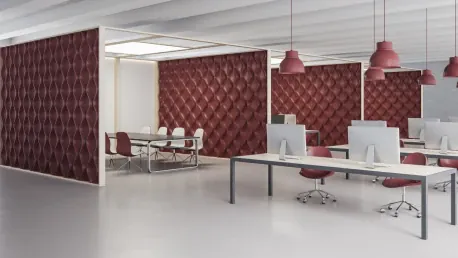The modern workplace is increasingly focusing on employee satisfaction and productivity, emphasizing the significant impact of factors like acoustic design. Proper acoustic management can transform an office environment, making it a more comfortable and productive place for employees. The Covid-19 pandemic has further highlighted the need for better workspaces, as remote work revealed the shortcomings of traditional office designs, often leading to distractions and reduced productivity.
The Importance of Good Acoustics
Good acoustics play a vital role in enhancing the overall employee experience. When the acoustic environment is managed effectively, it can lead to improved focus, reduced stress, and increased overall workplace satisfaction. Employees are better able to concentrate on their tasks without the distraction of unwanted noise. This heightened concentration directly correlates with higher productivity levels, as workers can dedicate their attention to work-specific activities.
A workplace with poor acoustics, on the other hand, can lead to a range of negative effects. Increased noise levels can cause stress, reduce concentration, and ultimately decrease productivity. Employers who ignore acoustic considerations may find their teams struggling to perform at their best, encountering difficulties such as miscommunication or frustration due to constant environmental noise. Addressing these acoustic issues can thus prevent dissatisfaction and enhance collaboration within office spaces.
Metrics for Effective Acoustic Design
To create an optimal acoustic environment, it’s essential to understand and implement key acoustic metrics. The Sound Transmission Class (STC) is one such measure, indicating how well a structure blocks airborne sound. An STC rating provides insight into the capacity of walls, floors, and ceilings to prevent sound from passing through, making it a critical factor in the design process. Another important metric is the Noise Reduction Coefficient (NRC), which measures a material’s ability to absorb sound.
By focusing on these measurements, designers can achieve a balance between noise absorption, isolation, and overall sound quality. Implementing materials with high NRC values can greatly reduce the reverberation of unwanted noise, while a strong STC rating ensures that conversations and activities remain private and undisrupted. Together, these metrics provide the foundation for creating spaces that control and manage sound effectively, enhancing the auditory experience of everyone within the office.
A Holistic Approach to Acoustics
Creating an effective acoustic environment requires a holistic approach. This means considering ambient noise levels, acoustic absorption, resistance to sound transmission, and the adjacency of different work areas. Human perception also plays a significant role in how noise impacts employees. Factors such as the type of work being done and the personal preferences of the workforce must be taken into account.
By taking a comprehensive view, designers can address various elements that contribute to the acoustic environment. Carving out quiet zones for focused work while designing collaborative spaces with controlled noise levels ensures that the acoustic needs of diverse functions are met. This holistic approach ensures a well-rounded solution that meets both technical requirements and the experiential needs of employees, fostering a workplace where productivity and satisfaction go hand in hand.
Partition Strategies for Optimal Privacy
One of the key strategies for managing office acoustics is through thoughtful partition design. Full-height partitions and “Box-In-Box” rooms provide superior sound isolation, ensuring speech privacy even in open-plan offices. Full-height partitions are designed to account for mechanical and other systems, significantly improving acoustic isolation. These partitions are particularly effective in promoting confidentiality in discussions, preventing the spread of conversations across a broader office space.
Another method, the “Box-In-Box” approach, creates independent rooms within larger spaces, effectively preventing sound leakage. This technique involves building acoustically independent structures that circumvent typical penetrations compromising sound barriers. By ensuring fewer sound leaks and better control over each penetration point, this strategy provides an effective solution for maintaining acoustic integrity. These designs are beneficial in environments where privacy is paramount, such as meeting rooms and executive offices.
Mechanical System Design
The design of mechanical systems is another critical factor in acoustic performance. Properly designed systems prevent unintended sound transmission between different areas of the office. Techniques like zoning systems according to functional areas, using less transmissive materials, and incorporating duct liners and baffles are effective measures. This careful consideration minimizes instances where mechanical vibrations or noise from air diffusers disrupt the office’s auditory environment.
Environmentally tuned diffusers also contribute positively by creating background noise that masks offending sounds. This white noise can be an effective tool in maintaining a consistent sound environment, allowing employees to focus without abrupt interruptions. Implementing such mechanical design strategies ensures that the acoustic quality of a workplace is preserved, enhancing the overall functionality and comfort of office spaces.
Addressing Raised Access Floor Challenges
Raised access floors, while technically advantageous, often present acoustic challenges. These systems can compromise sound isolation if not carefully managed. It is recommended to extend partitions above the raised floor to the slab overhead, thus maintaining an intact sound envelope. By doing so, the chances of sound leakage through the floor are minimized, preserving the design’s acoustic integrity.
When designing office spaces, it is essential to consider alternatives that do not compromise acoustic integrity or to implement measures that mitigate the drawbacks of raised access floors. Exploring other flooring options or redesigning raised access systems to meet high-level acoustic needs can ensure that even the most demanding environments maintain their sound quality. Proper management of these challenges plays a significant role in ensuring a seamless acoustic experience for all office occupants.
Virtual Meeting Room Design
The shift toward virtual meetings has introduced new acoustic challenges. Virtual meetings tend to be louder, as sounds are more amplified through speakers and microphones. This amplification requires careful room design to reduce disturbances. Using quality microphone and speaker systems can significantly enhance sound clarity while reducing unwanted echoes and feedback.
Increasing the amount of sound-absorbing materials and tuning the walls specifically for virtual communications can greatly improve acoustic performance in these scenarios. Employing acoustic panels or specialized wall treatments can help manage the loudness associated with virtual meetings, ultimately reducing disruptions. These tailored approaches ensure that virtual interactions remain clear and professional, contributing to a well-balanced acoustic environment in modern office settings.
Conclusion
The contemporary workplace is placing greater emphasis on employee satisfaction and productivity, highlighting the significant role of factors such as acoustic design. Effective acoustic management can revamp an office setting, creating a more pleasant and efficient environment for workers. The Covid-19 pandemic has underscored the necessity for improved workspaces, as the shift to remote work unveiled the flaws of conventional office designs. These traditional setups often resulted in distractions and diminished productivity, revealing that the needs of a modern workforce are evolving.
Employers are increasingly recognizing that a well-managed acoustic environment can lead to higher morale, fewer distractions, and better overall work performance. This shift in awareness comes as businesses adapt to the lessons learned during the pandemic, understanding that both remote and in-office setups demand thoughtful design to optimize employee well-being and efficiency. By investing in better acoustic solutions, companies can foster a workplace that meets the needs of their employees, ensuring a more productive future.









